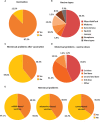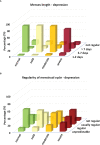Influence of COVID-19 pandemic and vaccination on the menstrual cycle: A retrospective study in Hungary
- PMID: 36387878
- PMCID: PMC9646704
- DOI: 10.3389/fendo.2022.974788
Influence of COVID-19 pandemic and vaccination on the menstrual cycle: A retrospective study in Hungary
Abstract
Observations of women and clinicians indicated that the prevalence of menstrual cycle problems has escalated during the COVID-19 pandemic. However, it was not clear whether the observed menstrual cycle changes were related to vaccination, the disease itself or the COVID-19 pandemic-induced psychological alterations. To systematically analyze this question, we conducted a human online survey in women aged between 18 and 65 in Hungary. The menstrual cycle of 1563 individuals were analyzed in our study in relation to the COVID-19 vaccination, the COVID-19 infection, the pandemic itself and the mental health. We found no association between the COVID-19 vaccination, the vaccine types or the COVID-19 infection and the menstrual cycle changes. We also evaluated the menstrual cycle alterations focusing on three parameters of the menstrual cycle including the cycle length, the menses length and the cycle regularity in three pandemic phases: the pre-peak, the peak and the post-peak period in Hungary. Our finding was that the length of the menstrual cycle did not change in any of the periods. However, the menses length increased, while the regularity of the menstrual cycle decreased significantly during the peak of the COVID-19 pandemic when comparing to the pre- and post-peak periods. In addition, we exhibited that the length and the regularity of the menstrual cycle both correlated with the severity of depression during the post-peak period, therefore we concluded that the reported menstrual cycle abnormalities during the peak of COVID-19 in Hungary might be the result of elevated depressive symptoms.
Keywords: COVID-19 pandemic; COVID-19 vaccines; SARS-Cov-2 infection; depression; human surveys; menstrual cycle.
Copyright © 2022 Barabás, Makkai, Farkas, Horváth, Nagy, Váradi and Zelena.
Conflict of interest statement
The authors declare that the research was conducted in the absence of any commercial or financial relationships that could be construed as a potential conflict of interest.
Figures





References
Publication types
MeSH terms
Substances
LinkOut - more resources
Full Text Sources
Medical
Miscellaneous

